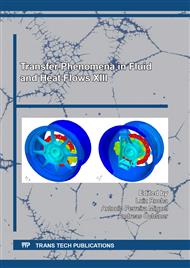[1]
J. Kim, J. Oh, H. Lee, Review on battery thermal management system for electric vehicles, Applied Thermal Engineering 149 (2019) 192-212.
DOI: 10.1016/j.applthermaleng.2018.12.020
Google Scholar
[2]
C. J. M. Lasance, The need for a change in thermal design philosophy, Electronics Cooling 1 (1995) 24-26.
Google Scholar
[3]
G.E. Moore, Cramming more components onto integrated circuits, Proceedings of the IEEE 86 (1998) 82-85.
DOI: 10.1109/jproc.1998.658762
Google Scholar
[4]
M. Zebarjadi, Electronic cooling using thermoelectric devices, Applied Physics Letters106 (2015) 203506.
DOI: 10.1063/1.4921457
Google Scholar
[5]
S. M. S. Murshed, C. A. N. Castro, A critical review of traditional and emerging techniques and fluids for electronics cooling, Renewable and Sustainable Energy Reviews 78 (2017) 821-833.
DOI: 10.1016/j.rser.2017.04.112
Google Scholar
[6]
C. Lasance, R. Simons, Advances in high performance cooling for electronics, Electronics Cooling 11 (2005) 22-39.
Google Scholar
[7]
A. Siricharoenpanich, S. Wiriyasart, A. Srichat, P. Naphon, Thermal cooling system with Ag/Fe3O4 nanofluids mixture as coolant for electronic devices cooling, Case Studies in Thermal Engineering 20 (2020) 100641.
DOI: 10.1016/j.csite.2020.100641
Google Scholar
[8]
A. F. Miguel, Optimal Y-shaped constructs heat sinks under different size constraints, International Journal of Heat and Mass Transfer 131 (2019) 64–71.
DOI: 10.1016/j.ijheatmasstransfer.2018.11.033
Google Scholar
[9]
A. F. Miguel, Constructal branching design for fluid flow and heat transfer, International Journal of Heat and Mass Transfer 122 (2018) 204-211.
DOI: 10.1016/j.ijheatmasstransfer.2018.01.095
Google Scholar
[10]
A. F. Miguel, A study of entropy generation in tree-shaped flow structures, International Journal of Heat and Mass Transfer 92 (2016) 349-359.
DOI: 10.1016/j.ijheatmasstransfer.2015.08.067
Google Scholar
[11]
A. F. Miguel, Occlusions in dendritic flow networks, Physica A Statistical Mechanics and its Applications 535 (2019) 122473.
DOI: 10.1016/j.physa.2019.122473
Google Scholar
[12]
B. Soni, A. F. Miguel, A. K. Nayak, A mathematical analysis for constructal design of tree flow networks under unsteady flow, Proceedings of the Royal Society A 476 (2020) 20200377.
DOI: 10.1098/rspa.2020.0377
Google Scholar
[13]
A. F. Miguel, Towards methodologies for optimal fluid networks design, Journal of Applied Fluid Mechanics 12 (2019) 1223-1229.
Google Scholar
[14]
M. B. Acikgoz, B. Akay, A. F. Miguel, M. Aydin, Airborne pathogens transport in an aircraft cabin, Defect and Diffusion Forum 312-315 (2011) 865-870.
DOI: 10.4028/www.scientific.net/ddf.312-315.865
Google Scholar
[15]
ANSYS FLUENT 16.2, User's Guide. www.fluent.com.
Google Scholar


